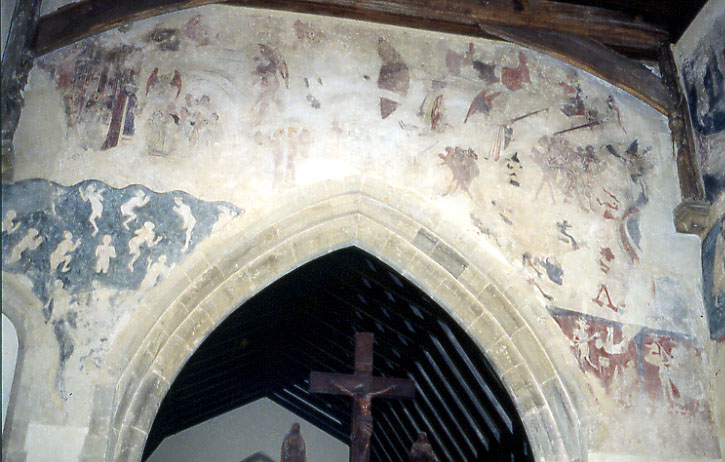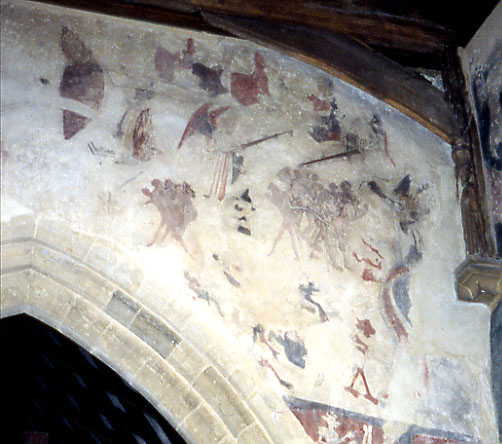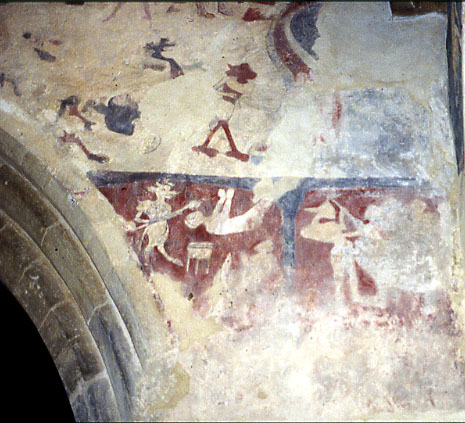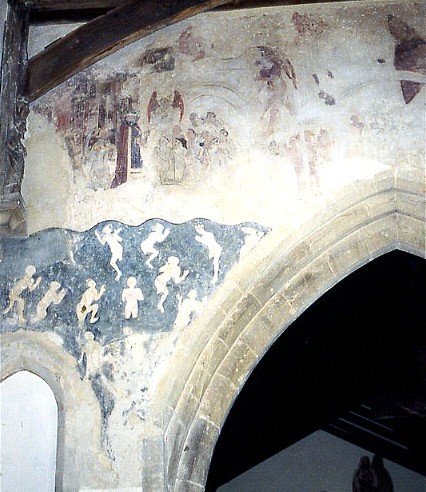Broughton, Cambridgeshire (†Ely) C.15
Doom

It is not clear where the figure of the judging Christ was in this Doom, since no trace of a painted figure has ever been found. But part of the curve of the rainbow can still be seen above the apex of the chancel arch, and behind this is a circle, presumably representing the world, a detail normally found between Christ’s feet, as at West Somerton. In cases like this, lowering of the roof some time after the painting was made is usually responsible, but I can find no information to confirm or deny this at present. But I think a figure of Christ was here at some time, mainly because a small kneeling figure to the lower right of the circle seems to be St John, in his usual intercessory position. The visible arc-segment may be part of the lower bow of a double rainbow, with the upper bow and Christ’s feet out of sight above the roofline now.

The painting has the exuberant wealth of detail common to many 15th century Dooms, and I think there is even a possibility that a traditional object of suspicion, the ale-wife who gives short measure, is included (on the damned side, of course), as she is at St Thomas, Salisbury¹, one of the most detailed 15th century Dooms. At Broughton I suspect she may be the small, mainly black figure just below and to the right of the angel/devil with large bat-like wings and a sword or flesh-hook. Investigation continues.

The upper right hand side of the painting, showing souls being received into Hell. Some detail has been lost, but groups of damned souls, one of them chained together and guarded by angels with swords, are fairly clear towards the right, where, a little below, part of the Mouth of Hell shows as an S-shaped curve. Some faint shapes also show at the very top of the painting, immediately below the roof-beams, but these are vague now.

Below on this side (pictured right), the torments of the damned are explored in detail. At the far right a devil stirs a huge cauldron with souls inside, while another, with hooves, horns and a face on his shoulder bastes an unfortunate dangling over a fire burning in a three-legged brazier. Above them, moving towards the remains of the Hell-Mouth, is another devil with enormous red feet and possibly two Janus-like faces. This is a particularly grotesque collection of devils, very much of its period.
Meanwhile, at the lower left of the painting and shown left, clearly visible souls (the painting has been restored) rise from their graves. Above them, a small group, the first two figures in it kneeling, meet St Peter, who stands in a blue robe and red cloak. Other groups, faint now, stand waiting, and at the left are some obscure remnants of the apartments of Heaven.
A very large Doom, full of incident and activity, although some details are certainly lost completely now.
The associated paintings of the Expulsion from Paradise and Adam Delving & Eve Spinning can just be glimpsed at the extreme right.
¹ Which will appear on the site as soon as I have a sufficiently good photograph